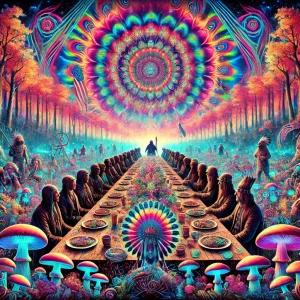
Thanksgiving occupies a paradoxical space in American consciousness, its myth obscuring a deeper, more complicated truth. For some, Thanksgiving is a celebration of gratitude and communion; for others, it represents a rewritten history—a narrative built on the erasure of Indigenous suffering and the glorification of traumatic events. Both perspectives are valid, and both can coexist, reflecting the complex nature of trauma itself. Just as Thanksgiving can be both a joyful gathering and a painful reminder, trauma often presents layers of meaning: what is observed on the surface rarely encompasses the full truth of what is felt or remembered beneath. The myth of Thanksgiving reminds us that the stories we tell often conceal as much as they reveal, echoing the hidden depths of personal and collective wounds.
Through the lens of psychedelics, Thanksgiving becomes more than a sanitized myth. It serves as a metaphor for the potential of shared spaces—places where people with diverse experiences, histories, and perspectives meet, grapple with their differences, and strive for healing and understanding. This dynamic echoes not only in the broader cultural discourse but also in how psychedelics are reshaping the landscape of recovery.
Thanksgiving as Myth, Psychedelics as Metaphor
The Thanksgiving story, though flawed, persists because it speaks to a universal human longing: the possibility of connection across divides. Psychedelics amplify this longing, offering a means to transcend barriers of ego, identity, and history. In altered states of consciousness, individuals often experience profound interconnectedness—a dissolution of the separations that divide us from one another and from the world around us.
This sense of communion mirrors the mythic Thanksgiving table, reimagined as a space where reconciliation and shared purpose are possible. While Thanksgiving often obscures the struggles it represents, psychedelics compel us to confront them head-on. They invite us to engage with the painful truths of the past while envisioning a future grounded in empathy, reciprocity, and unity.
Bridging Indigenous Wisdom and Western Science
Indigenous cultures have long used psychedelics as tools for spiritual growth, community bonding, and healing. These practices are rooted in reciprocity—an understanding of one’s relationship with the Earth, others, and the divine. In contrast, Western approaches to psychedelics often focus on individual transformation, scientific validation, and therapeutic outcomes.
The psychedelic renaissance seeks to honor and integrate these traditions, though not without challenges. It’s a delicate balancing act: ensuring respect for Indigenous knowledge while advancing scientific research and accessibility. This merging of paradigms, when approached with care and humility, reflects Thanksgiving’s aspirational ideal—a shared table where differing worldviews enrich one another rather than compete for dominance.
Psychedelics in Recovery: Communion Across Differences
Nowhere is the theme of unity more evident than in the emerging role of psychedelics in recovery. Traditional recovery models have often been rigid, asking participants to adhere to a singular path—whether through spiritual surrender in 12-step programs or clinically structured behavioral therapy. Psychedelics offer a new possibility: a space where diverse recovery styles can coexist and complement one another.
Psychedelics in recovery support groups function as modern-day Thanksgiving tables, gathering people with vastly different experiences, beliefs, and approaches to healing. These groups embrace the multiplicity of recovery paths, blending spirituality, science, and Indigenous practices into a shared framework. Here, a person steeped in 12-step traditions might find common ground with someone pursuing mindfulness-based therapies or Indigenous-inspired ceremonies. The unifying thread is the psychedelic journey itself—a catalyst for breaking down barriers and fostering empathy.
A Communion of Healing
The myth of Thanksgiving invites us to imagine a table where past grievances are set aside for shared gratitude. Psychedelics in recovery transform this myth into action. They create a sacred space where the wounds of the past—personal and collective—are acknowledged and processed, not ignored. They encourage participants to celebrate their differences while seeking common ground, fostering a deep sense of belonging.
By integrating diverse approaches to recovery, psychedelics echo Thanksgiving’s core aspiration: the possibility of communion in the face of division. They remind us that healing isn’t a solitary endeavor but a collective journey. Around the modern Thanksgiving table—or within a psychedelic recovery group—we see a vision of what’s possible when we come together with humility, gratitude, and open hearts.




